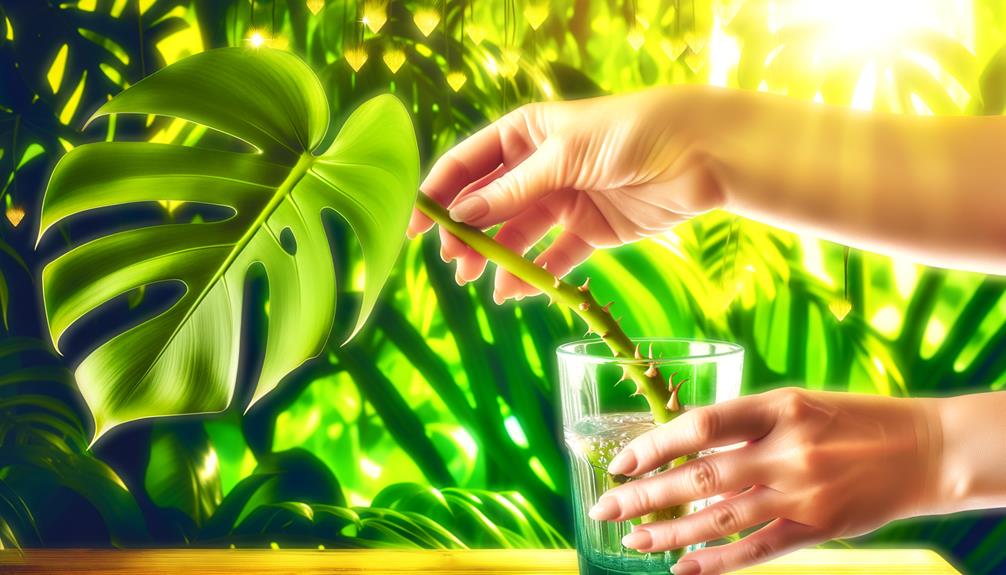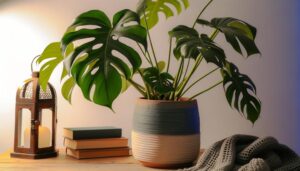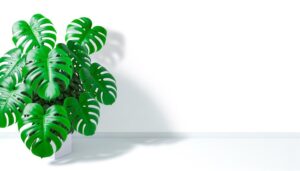Monstera Borsigiana Propagation Methods
To propagate Monstera Borsigiana, start by sterilizing pruning shears and gather rooting hormone. Choose a healthy stem with a node and an adjacent aerial root.
For water propagation, submerge the node in distilled water, changing it every 3-5 days. In soil propagation, plant the cutting in well-draining potting mix and maintain consistent moisture.
For air layering, make a diagonal cut below the node, apply moist sphagnum moss, and secure with plastic wrap. Each method requires bright, indirect sunlight for best root development.
Interested in troubleshooting and care tips? There's more to master.

Key Takeaways
- Use sterilized pruning shears to cut a healthy, disease-free stem with a node and aerial root.
- Dip the cut end in rooting hormone to stimulate root development.
- Place the cutting in distilled water, ensuring the node is submerged, and change water every 3-5 days.
- Plant the cutting in well-draining soil, burying the node and keeping leaves above the soil, while maintaining consistent moisture.
- Perform air layering by making a diagonal cut below the node, applying moist sphagnum moss, and wrapping it in plastic to maintain moisture.
Propagation Tools
Before you start propagating Monstera Borsigiana, gather essential tools including sterilized pruning shears, rooting hormone, and a clean container. Sterilized pruning shears minimize the risk of introducing pathogens, ensuring a healthy cut. Use isopropyl alcohol to sterilize these shears.
Rooting hormone, which contains auxins, promotes root development and increases the chances of successful propagation. Dip the cut end of the stem into the rooting hormone to stimulate root formation.
Finally, a clean container, preferably transparent, allows you to monitor root growth while maintaining a sterile environment. Using distilled water in this container prevents mineral buildup and contaminant introduction.
Choosing the Right Stem
Selecting a healthy, mature stem with at least one node and aerial root is crucial for successful Monstera Borsigiana propagation. Begin by inspecting your Monstera plant for stems that are robust and free from any signs of disease or damage.
Look for nodes, which are the knobby points on the stem where leaves and roots grow. Make sure there's an aerial root adjacent to the node, as this will aid in nutrient uptake during propagation.
Using sterilized pruning shears, make a clean cut just below the node. Aim for a stem segment that's 4-6 inches long, including the node and aerial root. This precise selection and cutting technique will greatly improve the likelihood of successful root development and growth in your new Monstera Borsigiana plant.
Water Propagation
To start water propagation, place the freshly trimmed Monstera Borsigiana stem segment into a clean container filled with room-temperature, distilled water, making sure the node and aerial root are fully submerged.
Monitor the water level regularly, keeping it consistent to avoid desiccation of the aerial roots. Change the water every 3-5 days to prevent bacterial growth, which can hinder root development.
Position the container in a location with indirect sunlight to facilitate photosynthesis without causing leaf scorch.
Use a transparent container to observe root growth.
Maintain a stable temperature between 65-75°F (18-24°C).
Avoid using tap water to prevent mineral buildup.
Confirm the cutting has at least one node.
Patience is key; root formation may take 2-4 weeks.
Proper water propagation guarantees healthy root development.
Soil Propagation
Switching from water propagation to soil propagation, you'll start by selecting a well-draining potting mix enriched with organic matter to guarantee ideal root aeration and nutrient availability. Fill a small pot with this mix, ensuring it has drainage holes to prevent waterlogging.
Take your Monstera Borsigiana cutting, ensuring it has at least one node and healthy aerial roots. Plant the cutting in the soil, burying the node and roots while keeping the leaves above the surface. Firmly press the soil around the base to secure it. Water thoroughly until you see excess water draining out.
Place the pot in a location with bright, indirect sunlight. Maintain consistent moisture without overwatering to promote best root development.
Air Layering Technique
For the air layering technique, you'll induce root growth on the Monstera Borsigiana stem while it's still attached to the parent plant.
Start by selecting a healthy stem with a node. Make a small, diagonal cut about one-third through the stem below the node. Keep the wound open using a toothpick or small piece of plastic.
Surround the cut area with moist sphagnum moss and wrap it in plastic wrap to retain moisture.
Ensure the following steps are precise:
- Choose a healthy stem: Look for a stem with a visible node.
- Make the cut: Use a sterilized blade to avoid infection.
- Keep the cut open: Insert a toothpick.
- Apply sphagnum moss: Keep it moist.
- Wrap with plastic: Secure with ties or tape.
Care for New Cuttings
Consistently monitor the moisture levels of the soil, checking it's neither too dry nor waterlogged to promote healthy root development in your new Monstera Borsigiana cuttings.
Use a soil moisture meter to achieve ideal hydration.
Position the cuttings in bright, indirect light, avoiding direct sunlight that may cause leaf burn.
Maintain ambient temperatures between 65-75°F (18-24°C) to facilitate root growth.
Mist the leaves regularly with distilled water to maintain high humidity levels, ideally around 60-70%.
Apply a balanced, water-soluble fertilizer at half strength every four weeks to provide essential nutrients.
Inspect the cuttings weekly for signs of root emergence and adjust care as needed to promote robust development.
Troubleshooting Common Issues
When propagating Monstera Borsigiana, you might encounter yellowing leaves, which often indicate nutrient deficiencies or improper light.
To prevent root rot, maintain proper drainage and avoid overwatering.
For pest control, regularly inspect for common pests like spider mites and treat with insecticidal soap if necessary.
Yellowing Leaves Causes
Yellowing leaves on your Monstera Borsigiana often indicate issues such as improper watering, nutrient deficiencies, or pest infestations. To diagnose the problem, observe the following potential causes:
- Overwatering: Saturated soil reduces oxygen availability, leading to chlorosis.
- Underwatering: Insufficient moisture can cause leaf dehydration and yellowing.
- Nutrient Deficiency: Lack of essential nutrients like nitrogen or magnesium can manifest as yellow leaves.
- Pests: Infestations by spider mites or aphids can drain plant sap, causing discoloration.
- Inadequate Light: Insufficient light reduces photosynthesis, resulting in leaf yellowing.
To address these issues, adjust your watering schedule, fertilize appropriately, inspect for pests, and secure your plant receives sufficient indirect light. This approach will help restore your Monstera Borsigiana's vibrant green foliage.
Root Rot Prevention
Addressing yellowing leaves is pivotal, but preventing root rot is equally significant for maintaining your Monstera Borsigiana's health.
Guarantee proper drainage by using a well-aerated potting mix, such as one containing perlite, orchid bark, and peat moss. Avoid overwatering; check soil moisture by inserting your finger 1-2 inches deep—water only when the topsoil feels dry. Opt for pots with drainage holes to prevent water accumulation at the roots.
Maintain a moderate humidity level around 60%, and provide indirect sunlight to promote healthy growth.
If signs of root rot appear, like mushy, discolored roots, remove the affected parts with sterilized scissors. Repot the plant in fresh, well-draining soil to prevent further infection. Regular monitoring is vital for early detection and intervention.
Pest Control Tips
Identifying and managing common pests like spider mites, aphids, and mealybugs is crucial to guarantee your Monstera Borsigiana thrives. First, regularly inspect the underside of leaves for pest activity. If you notice tiny webs or sticky residue, immediate action is necessary. Utilize insecticidal soap or neem oil for treatment. Ensure adequate ventilation to reduce humidity, as it creates an unfavorable environment for pests.
- Inspect Leaves: Check for discoloration, holes, or webbing.
- Use Insecticidal Soap: Apply directly to affected areas.
- Neem Oil: Effective for preventing and treating infestations.
- Maintain Air Circulation: Use fans to keep air moving around plants.
- Isolation: Quarantine new or infested plants to prevent spread.
Conclusion
To sum up, propagating Monstera borsigiana is like opening a botanical treasure chest. By mastering tools, selecting ideal stems, and using water, soil, or air layering techniques, you'll guarantee healthy new growth.
Remember, nurturing your cuttings with proper care and addressing issues promptly will yield strong, vibrant plants. Embrace these methods and watch your Monstera collection flourish, transforming your space into a lush haven.
With scientific accuracy, your propagation efforts will surely thrive.






